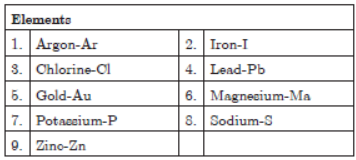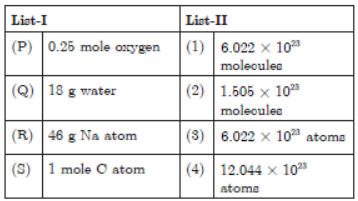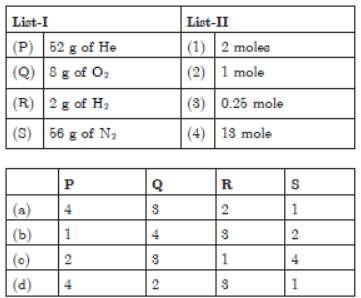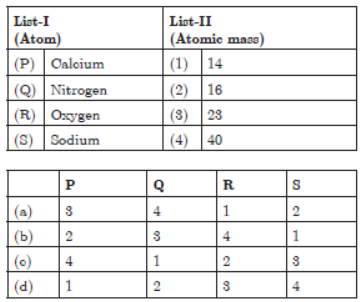Please refer to Atoms and Molecules MCQ Questions Class 9 Science below. These MCQ questions for Class 9 Science with answers have been designed as per the latest NCERT, CBSE books, and syllabus issued for the current academic year. These objective questions for Atoms and Molecules will help you to prepare for the exams and get more marks.
Atoms and Molecules MCQ Questions Class 9 Science
Please see solved MCQ Questions for Atoms and Molecules in Class 9 Science. All questions and answers have been prepared by expert faculty of standard 9 based on the latest examination guidelines.
MCQ Questions Class 9 Science Atoms and Molecules
OBJECTIVE QUESTIONS
Question. Some elements along with their symbols are enlisted in the given table:

Identify the incorrect representation of symbols.
(a) 4, 5 and 6
(b) 1, 2, 4, 5 and 9
(c) 2, 6, 7, and 8
(d) 3, 6 and 7
Answer
C
Question. Chemical formula of ferric oxide is
(a) FeO
(b) Fe2O3
(c) Fe3O4
(d) none of these
Answer
B
Question. The molecular formula P2O5 means that
(a) a molecule contains 2 atoms of P and 5 atoms of O
(b) the ratio of the mass of P to the mass of O in the molecule is 2 : 5
(c) there are twice as many P atoms in the molecule as there are O atoms
(d) the ratio of the mass of P to the mass of O in the molecule is 5 : 2.
Answer
A
Question. An atom is the
(a) smallest particle of matter known
(b) smallest particle of a gas
(c) smallest particle of an element that can take part in a chemical change
(d) radioactive emission
Answer
C
Question. How many elements are present in one formula unit of Al(OH)3?
(a) 3
(b) 4
(c) 5
(d) 6
Answer
A
Question. Some elements and ions with their valencies are enlisted in the given table:

Select the incorrect match.
(a) 4, 5, 7 and 9
(b) 4, 6 and 7
(c) 1, 8, 9 and 10
(d) 2, 3, 5 and 9
Answer
B
Question. All samples of carbon-di-oxide contain carbon and oxygen in the mass ratio 3 : 8. This is in agreement with the law of
(a) conservation of mass
(b) constant proportions
(c) multiple proportions
(d) gaseous volumes
Answer
B
Question. What mass of carbon-di-oxide ^CO2h will contain 3.011 × 1023 molecules?
(a) 11.0 g
(b) 22.0 g
(c) 4.4 g
(d) 44.0 g
Answer
B
Question. The total number of electrons present in 16 g of methane gas is
(a) 96.352 × 1023
(b) 48.176 × 1023
(c) 60.22 × 1023
(d) 30.110 × 1023
Answer
C
Question. A chemical equation is always balanced to fulfil the condition of
(a) Dalton’s atomic theory
(b) law of constant composition
(c) law of multiple proportions
(d) law of conservation of mass
Answer
D
Question. Identify the incorrect statement.
(a) The building blocks of all matter are atoms.
(b) Atoms are very small. They cannot be seen by the naked eye.
(c) The size of an atom is expressed in metres.
(d) An atom of hydrogen has the radius of the order of 10-10 m.
Answer
C
Question. Identify the correct statements.
1. In a compound such as water, the ratio of the mass of hydrogen to the mass of oxygen is always 8 : 1.
2. If 9 g of water is decomposed, 1 g of hydrogen and 8 g of oxygen are always obtained.
3. In ammonia, nitrogen and hydrogen are always present in the ratio 3 : 14 by mass.
4. Many compounds are composed of two or more elements and each such compound has the same elements in the same proportions.
(a) 1 and 3
(b) 1, 2 and 3
(c) 2 and 4
(d) All of these
Answer
C
Question. Which of the following is a triatomic molecule?
(a) Carbon-di-oxide
(b) Ammonia
(c) Helium
(d) Sugar
Answer
A
Question. The atomic mass of sodium is 23. The number of moles in 46 g of sodium are
(a) 1
(b) 2
(c) 2.3
(d) 4.6
Answer
B
Question. Select the incorrect match.
1. N2O4 -Dinitrogen tetroxide
2. HCl-Hydrogen chloride
3. CO-Carbon dioxide
4. PCl5-Phosphorus trichloride
(a) 1 and 2
(b) 3 and 4
(c) 1 and 3
(d) 2 and 4
Answer
B
Question. Molecular mass is defined as the
(a) mass of one atom compared with the mass of one molecule
(b) mass of one atom compared with the mass of one atom of hydrogen
(c) mass of one molecule of any substance compared with the mass of one atom of C-12
(d) none of the above
Answer
C
FILL IN THE BLANK
Question. The abbreviation used for lengthy names of elements are termed as their ………
Answer
symbol.
Question. Mole is link between the ………. and ………
Answer
mass of atoms & number of atoms.
Question. Ionic compounds are formed by the combination between ………. and ………
Answer
metal and non-metals.
Question. Those ions which are formed from single atoms are called ………
Answer
simple ions.
Question. The valency of an ion is ……… to the charge on the ion.
Answer
equal.
Question. Clusters of atoms that act as an ion are called ……… ions.
Answer
polyatomic
TRUE/FALSE
Question. Formula mass of Na2O is 62 amu.
Answer
True
Question. 22 gm of CO2 consists of 1 mole.
Answer
False
Question. Formula for sulphur dioxide is SO3.
Answer
False
Question. Those particles which have more or less electrons than the normal atoms are called ions.
Answer
True
MATCHING QUESTIONS
Question.


Answer
(b) P – 2, Q – 1, R – 4, S – 3
Question.

Answer
(a) P – 4, Q – 3, R – 2, S – 1
Question.

Answer
(c) P – 4, Q – 1, R – 2, S – 3
ASSERTION AND REASON
Question. Assertion : Number of gram-molecules of SO2Cl2 in 13.5 g of sulfuryl chloride is 0.1.
Reason : Gram molecular mass is equal to one gram molecule.
Options:
(a) Both assertion (A) and reason (R) are true and reason (R) is the correct explanation of assertion (A).
(b) Both assertion (A) and reason (R) are true but reason (R) is not the correct explanation of assertion (A).
(c) Assertion (A) is true but reason (R) is false.
(d) Assertion (A) is false but reason (R) is true.
Answer
A
Question. Assertion : A molecule is the smallest particle of an element or a compound which is capable of free existence.
Reason : The number of atoms present in one molecule of the substance is called its atomicity.
Options:
(a) Both assertion (A) and reason (R) are true and reason (R) is the correct explanation of assertion (A).
(b) Both assertion (A) and reason (R) are true but reason (R) is not the correct explanation of assertion (A).
(c) Assertion (A) is true but reason (R) is false.
(d) Assertion (A) is false but reason (R) is true.
Answer
B
Question. Assertion : Atomicity of O3 is 3.
Reason : 1 mole of an element contains 6.023 × 1023 atoms.
Options:
(a) Both assertion (A) and reason (R) are true and reason (R) is the correct explanation of assertion (A).
(b) Both assertion (A) and reason (R) are true but reason (R) is not the correct explanation of assertion (A).
(c) Assertion (A) is true but reason (R) is false.
(d) Assertion (A) is false but reason (R) is true.
Answer
B
Question. Assertion : Atomic mass of aluminium is 27.
Reason : An atom of aluminium is 27 times heavier than 1/12th of the mass of carbon-12 atom.
Options:
(a) Both assertion (A) and reason (R) are true and reason (R) is the correct explanation of assertion (A).
(b) Both assertion (A) and reason (R) are true but reason (R) is not the correct explanation of assertion (A).
(c) Assertion (A) is true but reason (R) is false.
(d) Assertion (A) is false but reason (R) is true.
Answer
A
Question. Assertion : 1 amu equals to 6 × 10-24 g.
Reason : 1.66 × 10-24 g equals to 1/12th of mass of a C – 12 atom.
Options:
(a) Both assertion (A) and reason (R) are true and reason (R) is the correct explanation of assertion (A).
(b) Both assertion (A) and reason (R) are true but reason (R) is not the correct explanation of assertion (A).
(c) Assertion (A) is true but reason (R) is false.
(d) Assertion (A) is false but reason (R) is true.
Answer
B
Question. Assertion : Pure water obtained from different sources such as river, well, spring, sea always contains hydrogen and oxygen combined in the ratio of 1 : 8 by mass.
Reason : A chemical compound always contains same elements combined in same fixed proportion by mass.
Options:
(a) Both assertion (A) and reason (R) are true and reason (R) is the correct explanation of assertion (A).
(b) Both assertion (A) and reason (R) are true but reason (R) is not the correct explanation of assertion (A).
(c) Assertion (A) is true but reason (R) is false.
(d) Assertion (A) is false but reason (R) is true.
Answer
A
Question. Assertion : One mole of molecules has mass equal to gram molecular mass and contains Avogadro’s number of molecules or has a volume of 22.4 L at STP if the substance is a gas.
Reason : One mole of an ionic compound has mass equal to gram formula unit mass and contains Avogadro’s number of formula units.
Options:
(a) Both assertion (A) and reason (R) are true and reason (R) is the correct explanation of assertion (A).
(b) Both assertion (A) and reason (R) are true but reason (R) is not the correct explanation of assertion (A).
(c) Assertion (A) is true but reason (R) is false.
(d) Assertion (A) is false but reason (R) is true.
Answer
B
Question. Assertion : The molecular mass and formula unit mass of a substance is the sum of atomic masses of all the atoms in the molecular formula or formula unit of a compound.
Reason : The only difference between the molecular mass and formula unit mass is that, former is for molecular compounds (covalent compounds) and latter is for ionic compounds. However, their numerical value is the same.
Options:
(a) Both assertion (A) and reason (R) are true and reason (R) is the correct explanation of assertion (A).
(b) Both assertion (A) and reason (R) are true but reason (R) is not the correct explanation of assertion (A).
(c) Assertion (A) is true but reason (R) is false.
(d) Assertion (A) is false but reason (R) is true.
Answer
B